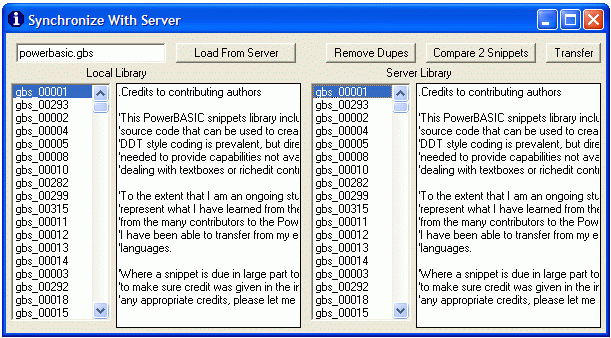
gbSnippets - Online Help
 This page provides the latest online Help information for gbSnippets,
a freeware program which provides an extremely easy-to-use
method of storing and searching single and multi-line text data.
Use it for phone numbers, birthdays, recipes, group lists, blogs,
diaries - anything you want to save, search or share!
This page provides the latest online Help information for gbSnippets,
a freeware program which provides an extremely easy-to-use
method of storing and searching single and multi-line text data.
Use it for phone numbers, birthdays, recipes, group lists, blogs,
diaries - anything you want to save, search or share!
The links above point to sections of this page. The page is a bit
long, but having a single page with all Help information on it
makes it especially easy to browse through gbSnippets Help.
The Games/Graphics and Programmer features are covered in detail
on separate Help pages:
A local Help file (gbSnippets.chm) is distributed with gbSnippets. The Help file
is usually updated more frequently than gbSnippets and you can always download the
latest version here.
Overview
gbSnippets allows a user to store lines/paragraphs of text data (called snippets), using
a familiar tree-structure to organize and display the information.
Once entered, the information may
be displayed or searched in a variety of ways. Information can be viewed,
edited, placed on the clipboard, sent by email, converted to HTML for posting on
the web, saved as wallpaper, merged with other gbSnippets files, synchronized to
libraries on the web, and printed. Snippet libraries encryption is supported.
gbSnippets's main window (below) consists of 3 basic areas - the tree structure (left),
the detailed content of the currently selected tree node (right), and a listing of the snippets
resulting from searches (bottom). Just above the tree structure is where search terms may be
entered, to produce a list of matching snippets. The tree, textbox, and listbox are the
primary areas where information is displayed. The menus, context menus, toolbar, and
search controls are used to control the display of information.
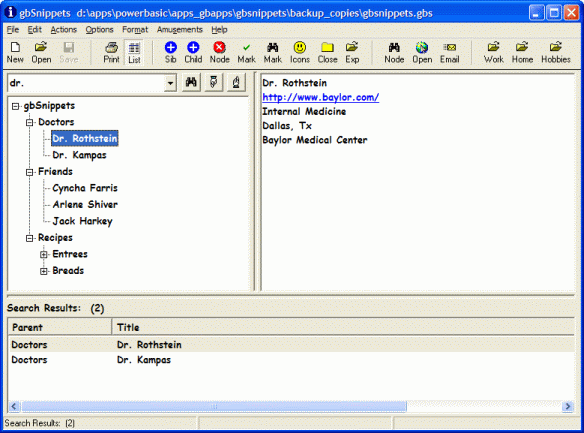
Each tree item (node) represents text - one line, several lines, or even many
paragraphs. The top line of the text is used to populate the tree node titles.
You can edit the top line in-place within the tree, or simply edit it in the
textbox. gbSnippets will synchronize your inputs!
URL's found in the textbox are active - they may be clicked to open
the selected URL in your default browser. URLs can also point to other
snippets in the current library.
Using Boolean (AND, OR) or exact search criteria, all snippets matching the
search are displayed in the listbox at the bottom of the screen. Navigation
buttons, found next to the combobox where the search term was entered, are used to
walk through the list of matching snippets.
In addition to the Tree Search (identifying a list of snippets which contain
the search term), a TextBox Search is also available which searches (and highlights)
the content of the currently selected snippet.
Snippets can be bookmarked. Then, a list of bookmarked snippets can be displayed
in the listbox. In addition to bookmarks, one node may be designated as the
home node, to which the tree can be returned at any time.
gbSnippets supports several layout options - positioning of the 3 main sections
and optionally hiding the search results listbox.
gbSnippets has one main menu, one main toolbar, and three context menus (one for the
tree, node content textbox, and search results listbox. The menu options are
discussed in detail below.
gbSnippets opens a single file at a time (multiple open files are not supported).
Also, a file is always opened in gbSnippets. When first started, gbSnippets
creates a default file or opens the previously opened file. If an attempt is
made to open a file that does not exist or is an invalid file, gbSnippets will
create a default file for viewing.
To make it easy to switch between commonly used snippet libraries, the main toolbar
has 5 QuickOpen selections, to which the user can assign a file name and display title.

Installation
|
gbSnippets is distributed as a single file, "gbsnippets.zip". Simply place the
file in a folder of your choice and unzip the file to create a folder "gbsnippets",
including all necessary subfolders (see image to the right) and supporting files.
I suggest putting it in a folder of its own at "c:\program files\gbsnippets", but
there's no requirement to use any particular folder.
gbSnippets does not use the Windows registry. To remove gbSnippets from your system,
simply delete the folder in which it resides.
| 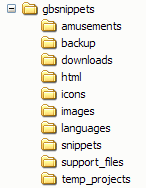
|

Menus
Like most Windows programs, gbSnippets provides a wide selection of menu
options. Here's a summary listing of the menus and submenus available from
the menu bar. Individual menus are discussed further down this page.

File
New
Open
Save
Save As ...
-----
Print Selected Node
Print Selected Node+Children
Print Node+Children (Titles)
Print Search Results (Titles)
Reload
-----
Import Data
Export Node to HTML
Export Node+Children to HTML
Shell To..
DOS
Open
Explorer
-----
Select FileA ...
Select FileB ...
Select FileC ...
Select FileD ...
Select FileE ...
-----
Clear Open File MRU
Clear Search Term MRU
-----
Exit
|
Edit
Cut
Copy
Paste
Delete
-----
Select All
-----
Edit TreeView Label
-----
Search Snippet (TextBox)
|
Actions
Screen Capture
Dialog Capture
Set Wallpaper
-----
Time-of-Day Alarm
Countdown Timer
Elapsed Time
-----
TimeStamp Selected Node
UnTimeStamp Selected Node
-----
TimeStamp Node+Children
UnTimeStamp Node+Children
-----
Set Password
Clear Password
-----
Select as Compare Left
Select as Compare Right
Display Comparison
-----
Synchronize With Server
|
Options
Confirm Delete
-----
AutoSave Changes on Exit
Save Settings on Exit
Load Last File on Startup
Enable URL Highlighting
Import as Single Node
InSitu Import
Convert TABs to Spaces...
Open HTML on Export
Use gbs# on Export
Recommend Password
-----
Alternate Layout
Fixed Splitter Bars
No Size Limits
File Name in Caption
-----
Save Tree Position
AutoEdit Tree Label
Tree Icons
Hide Root
-----
Large Print Title
-----
Show Search Results
AutoShow Search Results
Case Sensitive Search
Include Parent Title in Search
Search While Typing
-----
Clear Settings on Exit
On Top
-----
Indentation
Tab-2-Spaces
-----
Programmer Features
|
Format
Std Font
Std Bold Font
Std Fixed Font
Custom Font
-----
Black & White
Custom Color
Preset Color 1
Preset Color 2
Preset Color 3
-----
Select Custom Font
Select Custom FG Color
Select Custom BG Color
-----
Std Font Size +
Std Font Size -
-----
Custom Font Size +
Custom Font Size -
-----
Font Information
|
Amusements
Text Stereogram
Mosaic Stereogram
Matrix Screen Saver
-----
3D Models
-----
Lifetime Financial Planner
Stock Market Simulator
|
Help
Send Email To..
Author
New Recipient
Get Daily Message
Local Help ...
Online Help ...
Web Site
-----
Online Update ...
Go-Do List
-----
About ...
|
Here is additional information on each of the menu items.
File Menu
gbSnippets files are text files which contain the snippet and the information
needed to create the Tree display of the information. The files use a .gbs
file extension.
When gbSnippets is installed, it creates a subfolder called "gbsnippets" where
the several distributed snippet files are placed. However, there is no limitation
to where snippet files may be saved.
| New
| Creates a new file names "gbsnippets.gbs" and places it in the "snippets"
folder. If that filename exists, a different filename is used (typically,
"gbsnippets001.gbs"). If the current file has unsaved changes, the user is prompted
to save the changes before the new file is created.
|
| Open
| Opens an "Open File" dialog asking the user to select an existing
*.gbs file to open. If the current file has unsaved changes, the user is prompted
to save the changes before the dialog is opened. The selected file to open is added
to the file MRU (most recent used) list. If the selected file is encrypted,
the user is prompted to enter a password.
|
| Save
| Saves all changes, using the current filename. The user is not
prompted to confirm. If a password has been assigned, it is used to encrypt the
file.
|
| Save As
| Opens a "Save As" dialog, prompting the user to select a new
filename and location to save the current data. If the current file has
been changed, the changes are included in the new file. The current file
is not changed. If the current file has a password, it is also used to save
the new file.
|
| Print Selected Node
| The content of the currently selected node is printed.
A Printer dialog is opened to allow the user to select a printer.
|
| Print Selected Node+Children
| The content of the currently selected node and all of its
children are printed. A Printer dialog is opened to allow the user to select a printer.
|
| Print Node+Children (Titles)
| The title of the currently selected node is printed,
along with the titles of all children of that node.
A Printer dialog is opened to allow the user to select a printer.
|
| Print Search Results (Titles)
| The list of matching snippets, as currently displayed in the Search
Results listbox, is printed.
A Printer dialog is opened to allow the user to select a printer.
|
| Reload
| Reloads the current file, losing all changes and any newly
assigned password. The user is prompted for confirmation. The reloaded
file is placed at the top of the Open File MRU list. If the file to open
was saved with a password, entry of that password will be required to open
the file.
|
| Import Data
| The content of a gbSnippets data file (*.gbs) can be read and
added to the current file. This option pens an "Open File" dialog from which the user
can select a file to merge with the already opened file.
When importing snippets from another *.gbs file, the nodes under
the root of the file to import are placed under the root of the already opened file.
The "Options/Import as Single Node" menu option can be used to creates a single node
(named for the imported file) and puts all imported snippets under that node.
|
| Export Node to HTML
| The content of the currently selected node can be exported
to HTML format. Each snippet gets its own file, placed in a folder
(subfolder called "HTML", placed beneath the folder where gbSnippets was installed)
with no other files. Any pre-existing files contained in the folder are deleted when
an export is done. This simplifies finding the newly created files and makes it easy
to select/copy/move files as desired.
|
| Export Node+Children to HTML
| The content of the currently selected node, and its children,
can be exported to HTML format. When exporting an entire Tree (or node and its children),
each snippet gets its own file. gbSnippets will also create an index page containing a link
to each of the individual snippet files.
All of the exported snippets are placed in a folder (subfolder called "HTML", placed beneath
the folder where gbSnippets was installed) with no other files. Any pre-existing
files contained in the folder are deleted when an export is done. This simplifies
finding the newly created files and makes it easy to select/copy/move files as
desired.
|
| Shell To ...
| Opens the folder containing the currently opened file. The folder
may be opened in a DOS window, Windows folder window, or in Windows Explorer.
|
| Select FileA ...
| Allows the user to select a file which will be opened using
the FileA toolbar button. It also allows the user to select the text that will
be displayed on the toolbar.
There are also FileB through FileE toolbar buttons, for a total of 5 QuickOpen
toolbar buttons.
|
| Clear Open File MRU
| Removes all file names from the Open File MRU (most recently
used) list.
|
| Clear Search Term MRU
| Removes all entries from the Search Term MRU (most recently
used) list. The MRU list can be seen by pressing the down arrow on the
Tree Search combobox.
|
| Exit
| Closes gbSnippets. Depending on settings, closing gbSnippets also
saves changes, saves settings, and unregisters the gbSnippets hotkey.
|
Edit Menu
gbSnippets Edit menu options are pretty standard fare, All options apply to the
node content textbox except the "Edit TreeView Label" option, which applies to
the Tree.
Cut
| Removes the selected text and places a copy on the clipboard.
|
Copy
| Copies the selected text to the clipboard. The original text
is not affected.
|
Paste
| Pastes the current contents of the clipboard into the textbox
at the caret. If a selection has been made, pasting replaces the selected text.
|
Delete
| Deletes the selected text. The deleted text is NOT placed on
the clipboard.
|
Select All
| Selects all text in the textbox.
|
| Edit TreeView Label
| Initiates in-place editing of the Tree labels.
Each tree item, sometimes called a node, represents a block of text - one line,
several lines, or even many paragraphs. The top line of the text block is used
to populate the tree node titles (labels). You can edit the top line in-place
within the tree, or simply edit it in the textbox. gbSnippets will synchronize
your inputs between the Tree and the node content textbox!
|
Search TextBox
| Opens the TextBox Search dialog, allowing a user to Enter a search term
and to perform forward/backward searches in the node content textbox.
|
Actions Menu
Options are available which cover screen/dialog capture, timers, time stamping
and password management.
| Screen Capture
| Captures an image of the entire desktop and places it on the clipboard.
|
| Dialog Capture
| Captures an image of the gbSnippets main window (dialog) and places it on the clipboard.
|
| Set Wallpaper
| Once "Dialog Capture" has been used, this option sets the desktop
wallpaper to the dialog image. It's a convenient way of saving information
that gbSnippets displays - sort of like a post-it note at the center of the desktop.
|
| Time-of-Day Alarm
| When selected, asks the user to select a time of day when an
alarm is to be sounded. The alarm time and current time are shown in the first
section of the statusbar (it has 3 sections). When the time of day is reached,
the alarm sound file "gbsnippets.wav" will be played once.
The file is found in
the "support_files" subfolder, under the folder where gbSnippets was installed.
A user can replace the file with one of their own as long as the same file name
is used. The time-of-day display can be dismissed by unselecting the "Time-of-Day Alarm"
menu option.
|
| Countdown Timer
| When selected, asks the user for the number of minutes/seconds
to count down from. When the timer reaches zero the alarm sound file "gbsnippets.wav"
will be played once.
The file is found in the "support_files" subfolder, under the
folder where gbSnippets was installed. A user can replace the file with one of their
own as long as the same file name is used.
The countdown timer is shown in the second section of the statusbar (it has 3 sections).
The countdown timer display can be dismissed by unselecting the "Countdown Timer" menu option.
|
| Elapsed Time
| When selected, displays a running total of elapsed time, in
ss.d or mmm.ss.d formats, starting with zero as the time the selection was made. There
is no alarm sound associated with this timer.
The elapsed time is shown in the third section of the statusbar (it has 3 sections).
The elapsed time display can be dismissed by unselecting the "Elapsed Time" menu option.
|
| TimeStamp Selected Node
| Inserts the date/time as the second line of the snippet. If date/time
information is already there, it is replaced.
|
| UnTimeStamp Selected Node
| Removes the date/time line, if it exists, from a snippet.
|
| TimeStamp Node+Children
| Inserts the date/time as the second line of a selected snippet and
all of its children. If date/time information is already there, it is replaced.
|
| UnTimeStamp Node+Children
| Removes the date/time line, if it exists. from a selected snippet and all of its
children.
|
| Set Password
| Assigns a password to the currently opened file. When the file is
saved, the password will be used to encrypt the file. Replaces an already assigned
password.
|
| Clear Password
| Removes a password associated with a file. Once the password is
removed, encryption is not used to save the file.
|
| Select as Compare Left
| Stores the current textbox content for display in the
comparison window (left side).
|
| Select as Compare Right
| Stores the current textbox content for display in the
comparison window (right side).
|
| Display Comparison
| Opens a dialog with two side-by-side controls. The first contains
the content of the node content textbox. The second is empty so the user can paste
in text to compare to text in the first.
|
| Synchronize With Server
| Provides a side-by-side comparison of the snippets in a local
library and those from a server library. Snippets which do not match can
be identified and then manually transferred into the local library.
|
Options Menu
A wide variety of options are provided underneath the "Options" menu. These
menu options primarily allow a user to toggle an option ON/OFf, although a
few allow the user to modify a numerical value.
| Confirm Delete
| Requires the user to confirm deletion of Tree nodes.
|
| AutoSave Changes on Exit
| Automatically saves changes when exiting, without any
confirmation by the user.
|
| Save Settings on Exit
| Saves settings each time gbSnippets is exited. This satisfies
the occasional need where a user has experimented with settings but does not
want the changes saved.
|
| Load Last File on Startup
| On startup, opens the last file that was opened in gbSnippets.
|
| Enable URL Highlighting
| Allows the node content textbox to highlight, and make active,
URLs.
|
| Import as Single Node
| When importing snippets from another *.gbs file, the nodes under
the root of the file to import are placed under the root of the already opened file.
This option creates a node (named for the file) and puts all imported snippets
under that node.
|
| InSitu Import
| With this option you can simply drag and drop a text file over the
textbox to append the content of the file into the textbox.
|
| Convert TABs to Spaces in HTML Export
| HTML does not support TABs, so this option allows TAB characters
to be replaced with a series of spaces - placing text in the HTML files at
approximately the same location as the tabstops in the snippet.
|
| Open HTML on Export
| Automatically opens an exported HTML file. However, if a
node + its children are exported, gbSnippets created an index.htm file with
links to all of the exported snippets. In that case, the index.htm file is
automatically opened.
|
| Recommend Password
| Directs gbSnippets to generate a password, to be displayed
when the "Actions/Set Password" menu option is selected.
|
| Alternate Layout
| Switches between layout options, different primarily in whether the
Search Results listbox spans the width of the dialog, of matches the width of
the Tree.
|
| Fixed Splitter Bars
| Fixed the vertical and horizontal splitter bar positions with
respect to the left edge and bottom of the dialog. The default is for the splitter
bars to position themselves proportionately across the width/height of the dialog,
whenever the dialog is resized.
|
| No Size Limits
| Removes limits on the size of the main window. By default, the
dialog size of gbSnippets has minimum and maximum size limits. The minimum size
is 300x400 and the maximum size is 800x800. This option allows the user to size
the window to any dimension supported by the system resolution.
|
| File Name in Caption
| Places the name of the currently opened file to the gbSnippets caption.
|
| Save Tree Position
| When exiting, the position of the currently selected node is saved. When
gbSnippets is restarted, it attempts to open in the same position. This is meaningful
when the option to reload the last opened file is set. But even if that option is not set,
the saved Tree position is still used.
|
| AutoEdit Tree Label
| Automatically start in-place editing of a node when a node is
inserted (child or sibling).
|
| Tree icons
| Enables the use of icons in the Tree. By default, the Tree contains
lines connecting node. It also include "+/-" signs to indicate whether a node is a
parent and whether the node is expanded or collapsed. This option further adds icons
to indicate collapsed/expanded and parent/child status.
|
| Hide Root
| Removes the root node from the Tree icon. The root node still exists but
is not shown. This is strictly a cosmetic option - some folks like to see the root node,
some don't.
|
| Large Print Title
| Adds a large title (first line of the snippet) to the top of the page
when a snippet is printed. By default, no title is shown.
|
| Show Search Results
| Shows/hides Search Results listbox. This is particularly useful when
no search is being used. By hiding the listbox, more of the Tree and node content textbox
can be viewed.
|
| AutoShow Search Results
| Automatically displays the Search Results listbox when Enter is pressed in
the search combobox or when the "Tree Search" button is pressed. This happens only if
matching snippets are found.
|
| Case Sensitive Search
| Makes all Tree searches case sensitive. The default is case-insensitive
searches.
|
| Include Parent Title in Search
| Includes the immediate parent title, but not 2nd level or higher parent
titles, in a Tree search.
|
| Search While Typing
| Executes a Tree search for each character entered into the Tree search
combobox. Focus stays with the combobox. This is especially useful in minimizing
the number of keystrokes a user must enter to get the matching snippets.
|
| Clear Settings on Exit
| If the INI file setting get corrupted, all a user has to do is delete
the "gbsnippets.ini" file. Alternately, this option will delete the file when
gbSnippets is closed.
|
| On Top
| Places the gbSnippets at the top of the z-order for all open applications.
|
| Indentation
| Changes the number of spaces use to Indent or Outdent snippets lines.
Indentation adds a fixed number of spaces to the front of each line.
The default number of spaces is 4, but may be changed by using this option.
The current value is displayed in the menu as "Indentation (4)" - indicating that 4 spaces
are used to indent lines. Indent and Outdent options use the same value.
|
| Tab-2-Spaces
| Changes the number of spaces used when converting TAB characters
to spaces. The number of spaces used defaults to 4 spaces. However, the user can
change the value using this option. The current value is displayed
in the menu as "Tab-2-Spaces (4)" - indicating that 4 spaces will be use to
replace TABs.
|
| Programmer Features
| Enables the normally hidden programmer menu, toolbar,
and context menu options.
|
Format Menu
gbSnippets users can select from three pre-programmed, standard fonts or can define a
custom font. Whichever font is used is applied to the tree, node content textbox and
search results listbox. Here are the pre-programmed, standard values, and the default
values for the custom font.
- Std Font - MS Sans Serif, 10pt
- Std Bold Font - MS Sans Serif, 10pt
- Std Fixed Font - Courier New, 10pt
- Custom Font - Comic Sans MS, 10pt
The foreground and background of the 3 display areas can also be set by the
user. Four pre-set color schemes (including black on white) are provided, or
the user may select BG/FG colors of their choosing.
To simplify changing font size, menu options are also provided which will increment
or decrement the standard and custom font sizes. With these options, no other
font property is changed.
| Std Font
| Sets all control fonts to MS Sans Serif, 10pt. Does not change
the FG/BG colors.
|
| Std Bold Font
| Sets all control fonts to MS Sans Serif, 10pt, bold. Does not
change the FG/BG colors.
|
| Std Fixed Font
| Sets all control fonts to Courier New, 10pt, bold. Does not
change the FG/BG colors.
|
| Custom Font
| Sets all control fonts to Comic Sans MS, 10pt as a default,
but the user may select new values at any time.
|
| Black & White
| Sets all controls to display black letters on white background.
|
| Custom Color
| Sets all controls to the custom color. It defaults to a light
blue color, but may be changed by the user at any time.
|
| Preset Color 1
| Sets all controls to a preset FG/BG color scheme.
|
| Preset Color 2
| Sets all controls to a preset FG/BG color scheme.
|
| Preset Color 3
| Sets all controls to a preset FG/BG color scheme.
|
| Select Custom Font
| Opens a font selection dialog, allowing the user to select
the custom font (name, style, and size).
|
| Select Custom FG Color
| Opens a color dialog, allowing the user to select the
custom FG. If the "Options/Custom Color" menu option is selected, the
custom FG color will be applied to all controls.
|
| Select Custom BG Color
| Opens a color dialog, allowing the user to select the
custom BG. If the "Options/Custom Color" menu option is selected, the
custom BG color will be applied to all controls.
|
| Std Font Size +
| Increases the standard font size by 2 points.
|
| Std Font Size -
| Decreases the standard font size by 2 points.
|
| Custom Font Size +
| Increases the custom font size by 2 points.
|
| Custom Font Size -
| Decreases the custom font size by 2 points.
|
| Font Information
| Displays a messagebox with a summary of all fonts used
in gbSnippets.
|
Amusements Menu
gbSnippets includes a variety of games or graphical displays. These
have been included simply for the fun of it - I've enjoyed writing
them and I hope you enjoy playing/watching them. I expect to improve
on the ones that are here, and to add new ones in the future.
Each of amusements are written to occupy the same space as the search
results listbox. This allows the user to continue using gbSnippets even
as the amusement is being actively played.
Each of the amusements will have their own toolbar, displayed at the bottom
of the window rather than at the top. This helps clarify that the toolbar
is for the amusement and keeps it out of the way of using gbSnippets for its
primary purpose.
| Text Stereogram
| Demonstrates a stereogram created with nothing but text.
Includes animation of the 3D image.
|
| Mosaic Stereogram
| Demonstrates a stereogram created using small bitmaps
instead of text characters. Includes animation of the 3D image.
|
| Matrix Screen Saver
| Displays a screen saver similar to that used in the
movie Matrix.
|
| 3D Models/Lathe
| Displays a rotating 3D modles, as well as appying a lathe
action to user-entered points.
|
| Lifetime Financial Model
| Provides a simple, real-life model of investments, income,
and expenses over a person's lifetime. It's a very useful look at the
basics of saving for retirement.
|
| Stock Market Simulator
| A stock market game, where the user tries to buy/sell stocks
to reach a $1M fortune.
|
Help Menu
There are several special features included here, including the ability
to send snippets via email, download a daily message from the author
(regarding gbSnippets) and to perform an online update of the gbSnippets
executable.
| Send Email To..
| Opens the user's default email client with a
new message, addressed to a recipient selected from the email address
list kept by gbSnippets. Under this menu item is an option
to add recipient email addresses to the list. The author
of gbSnippets (Gary Beene) is automatically added to the
email address list.
|
| Get Daily Message
| Retrieves the most recent message posted on
the gbSnippets server. The message typically includes usage
tips, issues, and future release information.
|
| Local Help ..
| Opens the local Help file distributed
with gbSnippets. The filename is "gbsnippets.chm"
|
| Online Help ..
| Opens the user's default browser to the online
gbSnippets Help page.
|
| Web Site
| Opens the user's default browser to the gbSnippets
home page.
|
| Online Update ..
| Checks online to see if a new version is available.
If so, and the user confirms, the new version is downloaded and used
to update gbSnippets. Only the gbSnippets executable can be updated
this way. No other files are affected.
|
| Go-Do List
| This is my list of items I'm working on, or want to
add at a future date.
|
| About ..
| Opens an About dialog, giving the current version of
gbSnippets, a copyright message and a link to the gbSnippets home page.
|

Toolbar
The toolbar provides quick access to some of the more often used features of
gbSnippets.

Here's a description of the functions provided by the toolbar.

| New
|
create a new file and loads it into gbSnippets.
The new file will contain three example nodes - root, parent and child.
|

| Open
|
displays the "Open File" dialog,
from which the user can select a gbSnippets file to open.
|

| Save
|
saves all changes under the current
file name. It does NOT open the Save As dialog.
|

| Print
|
prints the content of the textbox.
|

| List
|
displays the Search Results listbox
control. The control may be empty if no search has been executed.
|

| New Sibling
|
adds a node to the Tree,
as a sibling to the selected node.
|

| New Child
|
adds a node to the Tree,
as a child of the selected node.
|

| Delete Node
|
deletes the selected node,
including children. If there are children,
the user will be asked to confirm the deletion.
|

| Bookmark Node
|
bookmarks the selected node.
This is no visible indicator that a node has been
bookmarked, but the Toolbar
|

| Display Bookmarked Nodes
|
finds all bookmarked
snippets and places the list in the Search Results control.
|

| Display Tree Icons
|
displays a pre-defined set
of icons in the Tree. Normally the Tree contains just lines
and "+/-" signs (to indicated whether a node is expanded or collapsed.
|

| Collapse All Nodes
|
collapses every node in the
Tree. To collapse just the selected node, use
the "Collapse Selected Node" option of the TreeView context menu.
|

| Expand All Nodes
|
expands every node in the Tree.
|

| Set Home Node
|
captures the current location in the Tree.
|

| Go To Home Node
|
returns to the Home location in the Tree.
|

| Search Node
|
pops open search dialog
which will search only the content of the textbox (the
currently selected node). To search from snippet to snippet within the Tree,
use the search tools found directly above the TreeView control.
|

| Open Selection
|
opens/executes the item defined
by the selected text. The textbox will normally highlight and make URLs active.
But in the event gbSnippets does not recognize an active string, this toolbar
button can be used to send highlighted text to the default client.
It can run EXEs, open files with their default clients, or simply open selected
text in NotePad.
|

| Send Email
|
opens an email to the author. gbSnippets
also allows the sending of emails to a user-defined contact list. The
Help/Email menu provides this function.
|

| FileA ... FileE
|
opens user-specified file. There are 5 icons, labeled by default as a, b, c, d, and e.
When the file is selected that the toolbar button will open, the user also
selects a 7-letter text title that will be displayed on the toolbar.
|

Context Menus
There are three context menus available - one for the tree, node content
textbox, and search results listbox. Here's a quick look at the commands
available in each of the context menus.
Tree Context Menu
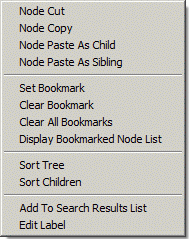
Search Results Context Menu

|
|
TextBox Context Menu
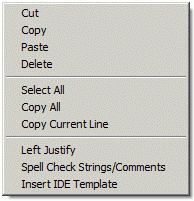
|
This section discusses each command of the three available context menus.
Each can be opened by right-mouse clicking over the Tree, Search Results
listbox, or textbox controls.
Tree Context Menu Options
gbSnippets uses a cut/copy/paste method of handling nodes, available from the
right context menu for the Tree. Nodes may not be dragged to a new location
(this may be added in future releases of gbSnippets).
Node Cut
| Removes the node from the Tree and stores the information
on a special gbSnippets clipboard for optional pasting back into the Tree.
This does NOT use the Windows clipboard.
|
|
|
Node Copy
| Copies the node to the special gbSnippets clipboard for
optional pasting back into the Tree. This does NOT use the Windows clipboard.
|
|
|
Node Paste as Child
| Pastes a cut/copied node into the Tree as a child of the
currently selected node.
|
|
|
Node Paste as Sibling
| Pastes a cut/copies node into the Tree as a sibling of the
currently selected node.
|
|
|
Delete
| Permanently deletes the currently selected node from the Tree.
Use this when the internal clipboard has a cut/copied node that you don't want
to use. Otherwise, it's usually best to use the Cut option.
|
|
|
Edit Label
| Starts an in-place edit of the currently selected snippet.
Remember that the title in the Tree and the first line of the full snippet
content in the textbox are kept synchronized. Whatever is typed in the in-place
Tree edit will replace the first line of content in the textbox, and
vice versa.
|
|
|
Set As Home Node
| Sets a node as Home. The "Go To Home Node" context menu
is used to select the Home node. This feature provides an easier way to
bookmark a single node and to more easily return to that node.
|
|
|
Go To Home Node
| Selects the home node in the tree
|
|
|
Set Bookmark
| Sets the bookmark property of the currently selected snippet.
There is no visual indication of the bookmark property of a snippet.
To see a list of all snippets whose bookmark properties are set, use the toolbar
"Bookmark Search" button. The list will be displayed in the Search Result listbox.
|
|
|
Clear Bookmark
| Clears the bookmark property of the currently selected snippet.
There is no visual indication of the bookmark property of a snippet.
|
|
|
Clear All Bookmarks
| Clears the bookmark property of all snippets in the Tree.
|
|
|
BookMark Search
| Lists all bookmarked snippets in the Search Result listbox. As with
normal search results, selecting an item in the list will also selected the item
in the Tree and display the full content of the snippet in the listbox.
|
|
|
Collapse All
| Collapses all nodes in the Tree (hides their children). By default,
nodes with children will either a "+" or "-" sign in front of them. The "+" sign
indicates that the node is collapsed, whereas the "-" sign indicates the node
is expanded.
|
|
|
Expand All
| Expands all nodes in the Tree (hides their children). By default,
nodes with children will either a "+" or "-" sign in front of them. The "+" sign
indicates that the node is collapsed, whereas the "-" sign indicates the node
is expanded.
|
|
|
Expand Node
| Expands the currently selected node, including all of its children
which also have sub-nodes.
|
|
|
New Sibling
| Creates a new node as a sibling to the currently selected node.
The new node is placed below the selected node.
|
|
|
New Child
| Creates a new node as a child to the currently selected node.
The new node is placed below the selected node. If the selected node has
content, the content is NOT lost. However, when a Tree node with children is
selected, the textbox is filled with a child count of the selected node. The
only way to view the content of a parent node is to delete all children of the
node.
|
|
|
Sort Tree
| Sorts every node in the Tree. The sort is ascending.
|
|
|
Sort Node Children
| Sorts the children of the currently selected node. It does not
sort sub-nodes. The sort is ascending.
|
|
|
Send To List
| Adds a node to the listbox. It's a way of creating a list of
snippets on which to take action (such as copying to the clipboard).
|
|
|
Tree Information
| Displays a popup messagebox that gives a count of the parents
children found within the Tree.
|
|
|
TextBox Context Menu
In general, the textbox context menus options are used to modify the content
of the textbox. If a text selection has been made, the menu options work on
the selected text or lines containing the selected text, depending on which
is appropriate.
Those menu options which work first on selections are marked with an "*".
Where the option works on lines, the effect begins with the lines
where a selection begins and ends.
Cut
| Removes the selected text and places a copy on the clipboard.
|
|
|
Copy
| Copies the selected text to the clipboard. The original text
is not affected.
|
|
|
Paste
| Pastes the current contents of the clipboard into the textbox
at the caret. If a selection has been made, pasting replaces the selected text.
|
|
|
Delete
| Deletes the selected text. The deleted text is NOT placed on
the clipboard.
|
|
|
Select All
| Selects all text in the textbox.
|
|
|
Copy All
| Copies all text in the textbox. The text is NOT selected.
Any selection remains selected.
|
|
|
Copy Current Line
| Copies the content of the current line (where the caret is
located) to the clipboard. The line is NOT selected. Any selection remains
selected.
|
|
|
Left Justify*
| Left justifies text (removes all leading spaces).
|
|
|
Trim Trailing Spaces*
| Removes all training spaces.
This option works on selected text. If no selection, works on entire contents of textbox.
|
|
|
TABs to Spaces*
| Converts TABs to spaces. The number of spaces used
defaults to 4 spaces. However, the user can change the value using
the "Options/Tab-2-Spaces" menu option. The current value is displayed
in the menu as "Tab-2-Spaces (4)" - indicating that 4 spaces will be use to
replace TABs.
This option works on selected text. If no selection, works on entire contents of textbox.
|
|
|
Indent*
| Adds a fixed number of spaces to the front of each line.
The default number of spaces is 4, but may be changed by using the
"Options/Indentation" menu option. The current value is displayed in
the menu as "Indentation (4)" - indicating that 4 spaces are used to indent lines.
Indent and Outdent options use the same value.
This option works on selected text. If no selection, works on entire contents of textbox.
|
|
|
Outdent*
| Removes a fixed number of spaces from the front of each
line. The default number of spaces is 4, but may be changed by using the "Options/Indentation" menu option. The current value is displayed in the menu as "Indentation (4)" - indicating that 4 spaces are used to indent lines.
If the number of spaces at the front of a line is less than the current
value, the spaces will be removed. Indent and Outdent options use the same value.
This option works on selected text. If no selection, works on entire contents of textbox.
|
|
|
Number Lines*
| Add a 5 digit number plus a separating space to each line.
The number format is "00001", where zeros are used to fill empty positions.
This option works on selected text. If no selection, works on entire contents of textbox.
|
|
|
UnNumber Lines*
| Removes a 5 digit number plus a separating space from each line.
This option verifies that the first 6 positions match the values entered by the
"Number Lines" context menu option. Any line not matching the format will not
be affected.
This option works on selected text. If no selection, works on entire contents of textbox.
|
|
|
Sort Ascending*
| Sorts lines in ascending order.
This option works on selected text. If no selection, works on entire contents of textbox.
|
|
|
Sort Descending*
| Sorts lines in descending order.
This option works on selected text. If no selection, works on entire contents of textbox.
|
|
|
Remove Blank Lines*
| Removes blank lines, where a blank line is defined as one containing
no characters or all spaces.
This option works on selected text. If no selection, works on entire contents of textbox.
|
|
|
Double Space*
| Adds an empty line below all lines, even lines which are empty themselves.
This option works on selected text. If no selection, works on entire contents of textbox.
|
|
|
Lower Case*
| Converts letters to lower case.
This option works on selected text. If no selection, works on entire contents of textbox.
|
|
|
Upper Case*
| Converts letters to upper case.
This option works on selected text. If no selection, works on entire contents of textbox.
|
|
|
Fixed Font
| Temporarily sets the font of the textbox to a fixed font. This is useful
when the content of a specific snippet is best viewed with columns lined up.
|
|
|
Search TextBox
| Opens the TextBox Search dialog, allowing a user to Enter a search term
and to perform forward/backward searches.
|
|
|
Word List
| Creates a sorted list of all the words (including duplicates)
found in the node textbox. Use the "Remove Duplicates" menu option to remove
duplicate words.
Warning: the list replaces the content of the textbox. gbSnippets
places the original content of the textbox onto the clipboard. Since Undo
operations are not currently supported in gbSnippets you'll have to paste
the clipboard contents back into the textbox to undo effects of this command!
|
|
|
Remove Duplicates
| Removes duplicate lines. The resulting list of unique lines is sorted.
|
|
|
Export to RTF/HTML
| Creates BOTH an RTF and HTML file.
The resulting files are placed in a folder (subfolder called "HTML", placed beneath
the folder where gbSnippets was installed) with no other files. Any pre-existing
files contained in the folder are deleted when an export is done. This simplifies
finding the newly created files and makes it easy to select/copy/move files as
desired.
|
|
|
Statistics
| Pops up a messagebox containing a summary of the information in
the textbox. Number of lines, longest/shortest line, average line length, and
number of characters (including split between letters, numbers and other characters).
It also provides a simple graph showing how many of each letter are found in
the textbox.
|
|
|
|
|
Search Results ListBox Context Menu
The list of matching snippets is particularly useful for browsing all matching
snippets of a search. Clicking on a snippet in the list also selects the
same snippet in the Tree, causing the entire snippet to be displayed in the textbox.
The list of matching snippets can be printed, or sent to the clipboard. Where
snippets are primarily one-line snippets, this is especially useful.
Remove From List
| Removes the selected matching snippet from the list. It does NOT
remove it from the Tree. This is useful when you're walking through a matching
list - removing it to leave behind only those snippets you've not yet seen or
are interesting in looking at again.
|
Clear List
| Completely clears the list. Keeping the list empty, when through
with it, can be useful to visually indicate when a new list has been generated.
|
Print List
| Prints the list - just the contents of the list (titles only), not the full
content of each snippet in the list. This is especially useful for printing
one-line snippets. It's also a great reason to place key information in the top line
of the snippet, rather than several lines down.
|
| Copy List to Clipboard
| Copies the list to the clipboard - just the titles of the snippets in
the list, not the full content of each snippet in the list.
|
| Copy Snippets to Clipboard
| Copies the content of each snippet listed in the listbox to the clipboard.
|

Layout Options
gbSnippets provides several ways to customize the layout to match the way you like to
view the data.
Alternate Layout
By default, the search result listbox is shown at the bottom of the main window, stretching
all the way across the window. Using the "Options/Alternate Layout" menu option, the
node content textbox can be made to extend from the top to bottom of the main window.
This limits the width of the search results listbox.
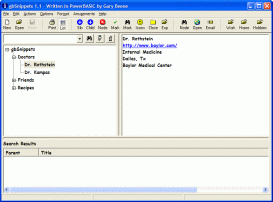
Standard Layout
|
| 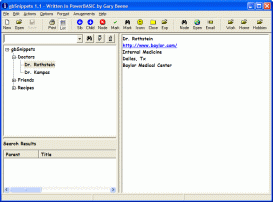
Alternate Layout
|
The standard layout display more information in the results of a Tree search,
whereas the alternate layout displays as much of the textbox content as possible.
Hiding the Search Results ListBox
| When a Tree Search is performed, the list of matching snippets is
shown in the Search Results listbox. This provides a convenient list of matching snippets,
from which the user can select a desired snippet to view. However, when no search
is in work it may be convenient to hide the Search Results listbox.
The "Options/Show Search Results" menu option or the toolbar "List" button can be
used to hide/show the Search Results listbox. Hiding the listbox provides the
maximum view of the contents of the Tree, which can be desirable when visually
browsing the Tree for snippets of interest.
When the Search Results are hidden, both the default and alternate layouts
look the same - only the Tree and node content textbox are shown.
| 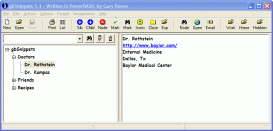
Search Results ListBox Not Shown
|
Fixed Splitter Bars
gbSnippets uses both vertical and horizontal splitter bars to
adjust the size of the various sections of the display. Normally, the splitter bars
will maintain their relative position if the main window is resized.
The "Options/Fixed Splitter Bars" menu option allows the user to lock the position
of the splitter bars. When used, this option fixes the distance from the left side of
the main window to the vertical splitter bar. It also fixes the distance from the
bottom of the main window to the horizontal splitter bar.
This option can ensure that the content of the Tree is always in view, as well as
to provide a maximum viewing area for the node content textbox as the window is resized.

QuickOpen
Although mentioned above in the Toolbar section, the QuickOpen feature of gbSnippets
deserves more discussion. There are 5 buttons on the toolbar, to which a user can
assign a library. Pressing one of those buttons opens the assigned library. So switching
between often-used library files is very simple and very quick.
By default, the toolbar items are simply labeled "a", "b", "c", "d", and "e" (see image).
The user may rename the toolbar items, as in the second image.

Default Labels
|
| 
Custom Labels
|
When switching to a new file using QuickOpen, the user will be prompted to save any existing
changes to the currently opened library.
When the File/Select FileA (or B-E) menu options are chosen, the user is
prompted to select the desired library file. Then the user is also asked to provide
an up-to-7 letters title for the library file. That title will be displayed in the
toolbar.

Active Links
gbSnippets supports hypertext links. Just as in a browser, the links are highlighted
and underlined, needing only to be clicked to open the link location. Links
may point to website URLs or to other snippets within the current library.
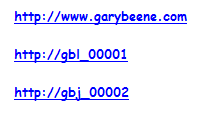
Active URL Link
This works exactly as you would expect. Simply type in a typical HTTP
address and the link will be active. Click on the link to open the URL
in your default browser.
Active Snippet Link
Elsewhere in Help, the use of gbs (assigned by gbSnippets author) and
gbu numbers (assigned by users) was discussed. An active snippet link can
be made to either snippet number type. Use "http://gbl_xxxxx" to jump
to a gbs# and use "http://gbj_xxxxx" to jump to a gbu#. The image to the
right shows both approaches.
In case you wonder, the "l" and "j" are simply mnemonics for Link
and Jump.

Searches
gbSnippets provides two separate methods of searching - a Tree Search and a Node
Search.
Tree Search
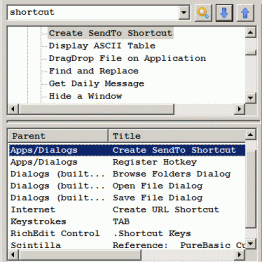 A tree may be searched for snippets which match one or more search terms.
To initiate a Tree Search, simply type in the search terms to the combobox located
just above the Tree and press Enter. Matching snippets will be displayed in
the search results listbox at the bottom of the page. The first matching
snippet is selected in the tree.
A tree may be searched for snippets which match one or more search terms.
To initiate a Tree Search, simply type in the search terms to the combobox located
just above the Tree and press Enter. Matching snippets will be displayed in
the search results listbox at the bottom of the page. The first matching
snippet is selected in the tree.
When multiple matching snippets are found, navigation between the matching
snippets can be done in two ways. Next to the combobox, where search terms are
entered, are two buttons - hands pointing up and down, corresponding to moving up
and down the list of matching snippets.
Alternately, clicking on a snippet in the listbox will jump to that specific
snippet - highlighting it in the tree and displaying its content in the textbox.
Tree searches support Boolean (AND, OR) searches as well as exact string
searches. Quotes are not used. These are all valid search terms:
- cookies - searches for the string "cookies"
- my cookies - searches for the exact string "my cookies"
- milk and cookies - searches for snippets with both words
- milk or cookies - searches for snippets with either word
There are several tree search options, all available from the "Options" menu. See
the earlier discussion on "Option" menu options. These control how a search will
be made and how search results will be displayed.
- Show Search Results
toggles display of the Search Results listbox
- AutoShow Search Results
displays the Search Results listbox whenever a Tree
search is executed. Applies when Enter is pressed after entering a search term
or when the "Tree Search" button is pressed (the one with the binocular icon).
- Case Sensitive Search
toggles case-sensitivity in searches. This does not apply
to a TextBox search, where case-sensitivity can be independently set.
- Include Parent Title in Search
Includes the title of the selected node in the
search. Only the immediate parent title is used (2nd-level or higher parent titles
are not included).
- Search While Typing
automatically executes a search whenever a key is entered
in the combobox. Focus stays with the combobox. This is especially useful in minimizing
the number of keystrokes a user must enter to get the matching snippets.
Finally, the last 10 search terms are placed in the combobox. Simply press the combobox down
arrow to display the most recent searches and select an item to repeat the search. Each time
a search is made, the search terms are added to the top of the dropdown list. Duplicate
entries are removed.
TextBox Search
The content of a selected node can be searched for a specific text string by
pressing F3 or by selecting the "Edit/Search Node" menu option to call up
a small dialog in which to enter the search term.
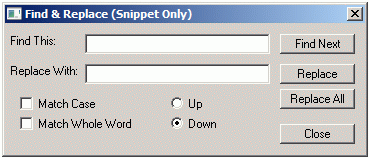
Enter or press one of the search buttons to find and highlight matching text. The
Enter key can also be repeatedly pressed to search forward through the node content.
A TextBox Search is limited to the content of the currently selected node. When the
end of the node content is reached and no further matches are found, pressing the
search buttons will result in a beep sound.
If a Tree Search has been previously made, the TextBox Search dialog will open with the first
word of the most recent Tree Search.
A TextBox Search does not support Boolean (AND,OR) searches. The search can be made
case-sensitive by selecting the checkbox on the TextBox Search dialog.
The TextBox Search dialog also allows replacement of the search term. Once a matching
text string is found, and highlighted, pressing "Replace" will replace the search
string with the replacement string.
The dialog also allows moving through the snippets found in the search results listbox.
The "Next Snippet" and "Previous Snippet" buttons do not move through the entire tree,
just the snippets in the listbox.
Search Commands: ..match, ..tally
In addition to the Tree and TextBox Search features, gbSnippets offers two
commands which return lists that are opened in NotePad as temporary text files
(see the discussion on Commands, further down this page).
The ..match command is entered as "..match searchterm", and returns
a list of all lines which contain "searchterm" (from one, or all snippets).
The specific snippets contaning the list is not identified (the Tree search
provides the list). The ..match command can conveniently provide just those
lines containing the search term without requiring the user to scroll through
individual snippets.
The ..tally command works on a user-defined list of search terms,
and returns a list of the number of times the terms are used in one, or all,
snippets. The list is kept in a simple text file, which can be accessed
by entering the "..tallylist" command.
..freq Command
Occasionally I'd like to know how many times a term is found in a list.
After using the textbox context menu "WordList" and "Sort" commands, using
..freq will display a list of how many times each term is used. The command
works equally well on counting duplicate lines.

Snippet Comparison
Sometimes you need to know if two snippets are the same, or if a potential
snippet matches an existing snippet. gbSnippets provides a popup dialog
(see the image to the right)
which can be used to compare any two texts. The two texts can be pasted into
the left/right textboxes.
Or, Action menu items can be used to selecting specific snippets to be
entered into the left and right textboxes.
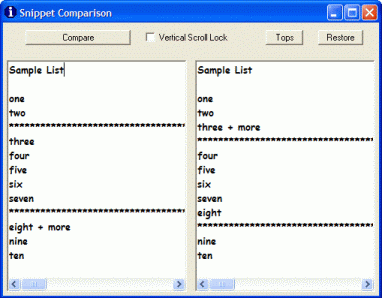 In the adjacent image you can see two snippets, containing lines "one" through
"ten", except that two lines have some additional text. When the Compare button is
pressed the text on each side is replaced as shown in the image, with "**********"
lines indicating where differences have been found.
In the adjacent image you can see two snippets, containing lines "one" through
"ten", except that two lines have some additional text. When the Compare button is
pressed the text on each side is replaced as shown in the image, with "**********"
lines indicating where differences have been found.
The window provides a scroll-locking feature to allow both side to be scrolled
up and down at the same rate. It has a Tops (display top line of both
snippets) and a Restore (replace comparison results with original text) features.

Sharing Snippets
gbSnippets provides several ways in which you can share your snippets with others.
Email Sharing
Once you create a list of email recipients, using the "Help/Send Email To..." menu option,
you can use gbSnippets to open your default email client with a message pre-addressed
to anyone on the list. The content of the snippet (or just the selection, if one
has been made) is placed on the clipboard, ready to be pasted into the email body
at your convenience.
Future versions of gbSnippets will allow you to send the email directly, without
having to work through your default email client.
HTML Sharing
You can export a single node, or even the entire tree to HTML format. When exporting
an entire tree (or node with children), each snippet gets its own file. gbSnippets
will also create an index page containing a link to each of the individual snippet
files.
All of the exported snippets are placed in a subfolder called "HTML", placed beneath
the folder where gbSnippets was installed, with no other files. Any pre-existing
files contained in the folder are deleted when an export is done. This simplifies
finding the newly created files and makes it easy to select/copy/move files as
desired.
Future versions of gbSnippets will include the ability to FTP the files directly
to your website.

Encryption
gbSnippets allows snippet data files to be encrypted. The current encryption method
uses a password string to encrypt the file. Currently, a fairly simple encryption
method is used. Future versions of gbSnippets will include stronger encryption algorithms.
However, the mechanism for handling encrypted files will be the same. A user creates
a file, adds content, assigns a password and then saves the file. The assigned password
will be used to encrypt the content and save it to disk.
gbSnippets can recognize when a file is encrypted. When an encrypted file is opened,
the user will be asked to supply the password. When the file is saved, the password
will be used again, unless the user changes the password before saving it.
Once the file is opened, the password can be changed or cleared. When a password is
cleared, the next time the snippet file is saved, it will be saved unencrypted.
Note: When Windows saves a file it can write the file anywhere on the disk -
not necessarily overwriting an earlier saved copy. So if you've previously saved
your data as unencrypted, then save it again as encrypted, the hard drive may contain
a recoverable copy of the unencrypted data. If this is of concern to you, I suggest
using one of the many available utilities which erase unused portions of hard drives.
Also, when you export content of an encrypted file to RTF/HTML, be aware that the
exported RTF/HTML files are not encrypted.

Screen Capture
Once information has been displayed in gbSnippets, you can create an image
of the dialog. The image is placed on the clipboard ready for pasting into
any application (word processor, email client, etc.) you choose.
Or, once captured, the dialog image can be used as your desktop wallpaper,
It's like placing a single post-it note in the middle of your screen! I use
it to display information that I'll need to refer to several times over the
next day or too. Then, when I'm done, change my wallpaper to something else.

Timers
When you're working, you may want to track time-related information. gbSnippets
provides 3 different timers, whose information are displayed in the statusbar
along the bottom of the main window.
- Time-of-Day - it's just a clock, but located in the statusbar where your
eyes don't have to move much to see it.
- Countdown Timer - allows you to set an alarm to go off after a specified
length of time.
- Elapsed Time - provides how many minutes/seconds you've been at work.

Unique Snippet Numbers
gbSnippets supports two optional methods for uniquely identifying a snippet
- user numbering and gbSnippets default numbering.
gbSnippet Numbering System
Each of the snippets in the libraries distributed with gbSnippets has been
assigned a unique number such as "gbs_00001". These are referred to as gbs#'s.
The number portion must consist of five digits.
This unique identifier can be placed anywhere in the snippet, but I've placed
them all at the end of the snippet. When a snippet is selected in the
Tree, the gbs# is placed in the statusbar. Use of the gbs# is optional.
Two commands, ..gbs and ..addgbs, are provided to help manage the snippet
gbs#'.
If the ..gbs command is entered, a popup MsgBox provides information on
gbs# usage. The largest used number is displayed (so you know what number
to assign to the next snippet). Also the title of any snippets not containing
a gbs# is listed. Finally any gbs# duplicates (found more than once)
are listed.
If the ..addgbs command is entered, a gbs# is added to every snippet in the
library. The command is entered as "..addgbs 123", and the added gbs#'s
are numbered starting with "123". This command does not overwrite
and existing gbs#, so use with caution.
THe numbering system enables two significant features - server synchronization
and internal hypertext linking.
Internal Hypertext Linking
To create a link from one snippet to another, type in a link such as this
(L is for link):
The 'gbl' identifies the entry as a link to another snippet. The '00015'
identifies the specific snippet.
Server Synchronization
When server synchronization is performed (see the discussion elsewhere on this
Help page), snippets with the same gbs#'s are compared to one another.
User Numbering System
In case a user wants to provide their own numbering system and to synchronize
with their own server libraries, gbSnippets also support the use of 'gbu'
numbering. It works exactly as 'gbs' numbering. Additionally, hypertext links
to gbu#'s use a 'gbj' link like this (j is for jump):

Server Synchronization
gbSnippets can synchronize a local library with the same library found on
either the gbSnippets server or a user defined server!
Whenever a gbSnippets library is updated, it is placed on the gbSnippets server.
Use the Actions/Synchronize With gbSnippets Server menu option to pull up the following
screen, from which the server and local libraries of the same name can be compared
for changes, and differences added to the local library.
When the synchronization window is called, it automatically fills the left listbox
with the gbs#'s from the current library. Click on a gbs# to see it in the textbox
to the right of the list.
The dialog provides the following options.
User Server
If you have selected "Synchronize With User Server", the synchronization dialog
will look and operate the same, except that it will display gbu#'s (user numbers)
and download the library file from the user's server (the addresso of which is
entered using the ..users command).

Commands
Sometimes I add features to an application, but not really wanting to give the
feature prime time space on the menu or toolbar. Also, I like not having to
switch between the mouse and the keyboard. So, I sometimes add a "command"
feature which allows me to type in a command. With gbSnippets I've added command
options to the combobox.
In particular, search terms are examined against a list of potential "commands",
all of which start with ".." to avoid conflict with other legitimate search
terms. When a "..xxx" search term (command) is found, a corresponding action is
taken rather than completing the usual search.
Here are the commands gbSnippets currently recognizes. I may eventually move these
to menu/toolbar positions, but for now they must be entered via keyboard in the
combobox. Note: commands are recognized only when the Enter key is pressed while
the combox has focus.
Most of these commands are discussed in other sections, where their function
contributes to the features in that section (such as ..match is
discussed in the section on Search). The following list is more of a reference
list than a how-to section.
- ..x
| - exit from gbSnippets
| - ..user
| - allows user to input a server URL
| - ..servers
| - displays both user and gbSnippets servers
| - ..hex
| - display Textbox content in hex format
| - ..db
| - convert decimal to binary
| - ..dh
| - convert decimal to hex
| - ..hd
| - convert hext to decimal
| - ..match
| - lines containing search term (this snippet, w/o line numbers)
| - ..matchall
| - lines containing searcht erm (all snippets, w/o line numbers)
| - ..matchl
| - lines containing search term (this snippet, w/line numbers)
| - ..matchalll
| - lines containing searcht erm (all snippets, w/line numbers)
| - ..freq
| - displays count of duplicate lines in textbox
| - ..tally
| - # times pre-defined search terms are used (this snippet)
| - ..tallyall
| - # times pre-defined search terms are used (all snippets)
| - ..tallylist
| - open tally term list in NotePad
| - ..gbs
| - displays gbs# summary
| - ..addgbs
| - adds gbs# to all snippets. Caution: does not replace existing gbs#!
| - ..gbu
| - displays gbu# summary
| - ..addgbu
| - adds gbu# to all snippets. Caution: does not replace existing gbu#!
| | | | | | | | | | | | | | | | | | | |
In the list, the commands are grouped by related functions.

Request For Feature Suggestions
I'm completely open to suggestions from gbSnippets users. Tell me what you'd like
to see added!
 This page provides the latest online Help information for gbSnippets,
a freeware program which provides an extremely easy-to-use
method of storing and searching single and multi-line text data.
Use it for phone numbers, birthdays, recipes, group lists, blogs,
diaries - anything you want to save, search or share!
This page provides the latest online Help information for gbSnippets,
a freeware program which provides an extremely easy-to-use
method of storing and searching single and multi-line text data.
Use it for phone numbers, birthdays, recipes, group lists, blogs,
diaries - anything you want to save, search or share!

































 A tree may be searched for snippets which match one or more search terms.
To initiate a Tree Search, simply type in the search terms to the combobox located
just above the Tree and press Enter. Matching snippets will be displayed in
the search results listbox at the bottom of the page. The first matching
snippet is selected in the tree.
A tree may be searched for snippets which match one or more search terms.
To initiate a Tree Search, simply type in the search terms to the combobox located
just above the Tree and press Enter. Matching snippets will be displayed in
the search results listbox at the bottom of the page. The first matching
snippet is selected in the tree.

 In the adjacent image you can see two snippets, containing lines "one" through
"ten", except that two lines have some additional text. When the Compare button is
pressed the text on each side is replaced as shown in the image, with "**********"
lines indicating where differences have been found.
In the adjacent image you can see two snippets, containing lines "one" through
"ten", except that two lines have some additional text. When the Compare button is
pressed the text on each side is replaced as shown in the image, with "**********"
lines indicating where differences have been found.
